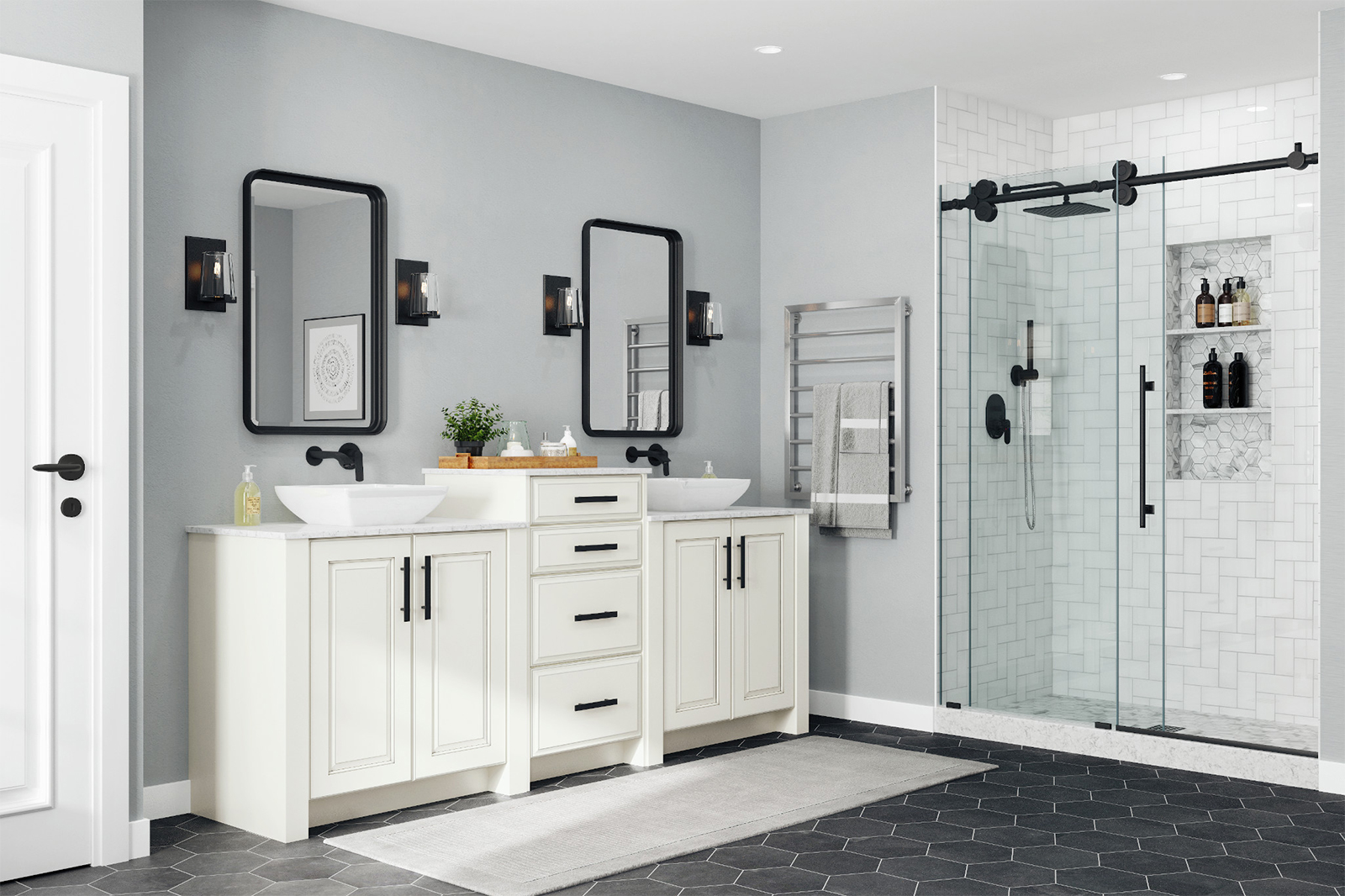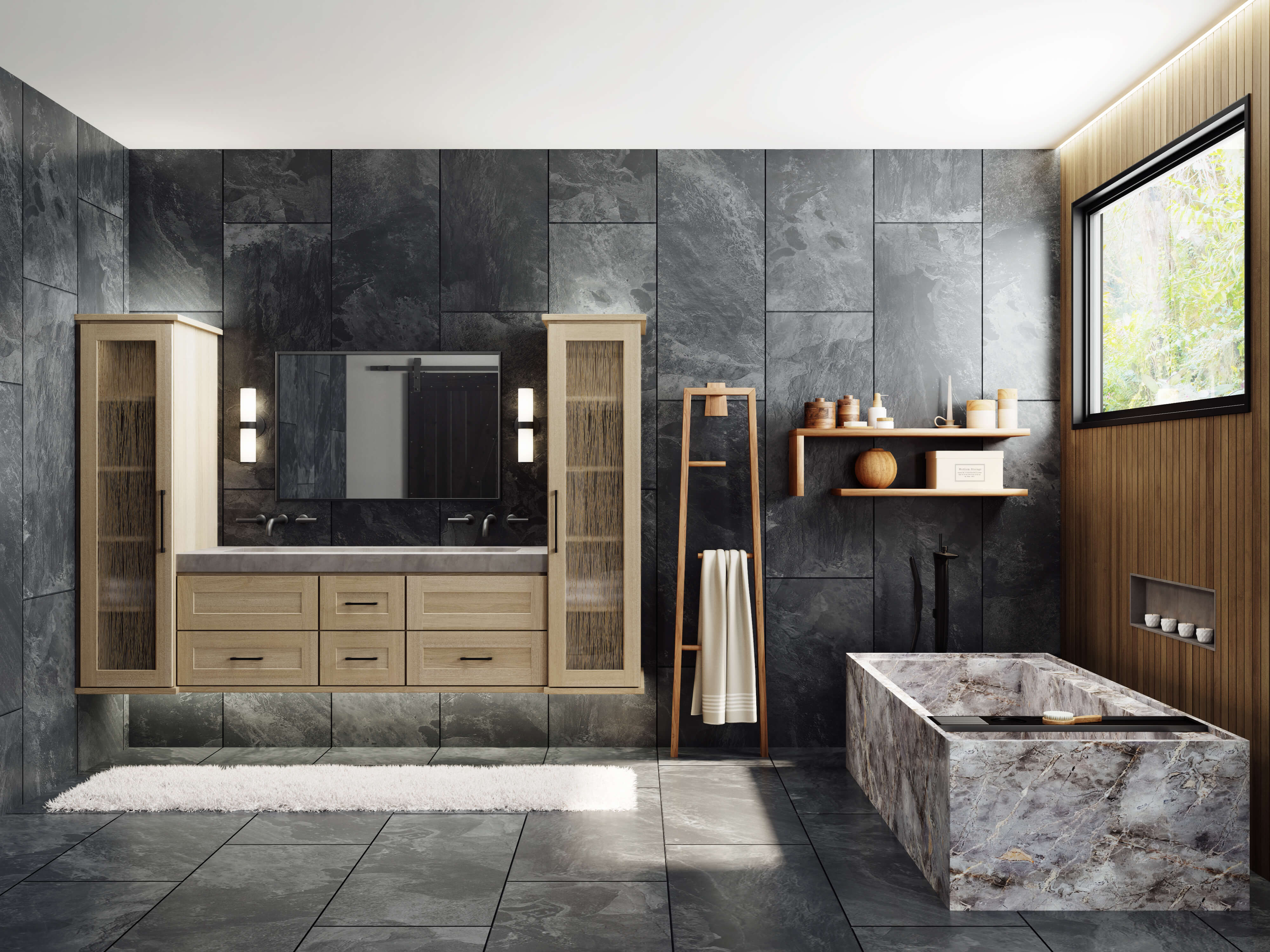The Appeal of Built-In Bathroom Vanities and Cabinets: Built In Bathroom Vanities And Cabinets

Built-in bathroom vanities and cabinets are increasingly becoming the preferred choice for homeowners seeking to create a functional and aesthetically pleasing bathroom space. Their advantages over freestanding options are undeniable, offering a unique blend of practicality and design appeal.
Space Utilization and Organization
Built-in vanities and cabinets are renowned for their ability to maximize space utilization in bathrooms. They seamlessly integrate with the bathroom’s architecture, eliminating the need for freestanding furniture that can take up valuable floor space. This creates a sense of openness and spaciousness, particularly in smaller bathrooms. The built-in design allows for custom configurations, tailored to the specific needs and dimensions of the bathroom. This customization enables the creation of dedicated storage spaces for toiletries, towels, and other bathroom essentials, promoting a clutter-free and organized environment.
Enhanced Aesthetics and Functionality
Built-in vanities and cabinets are a powerful tool for enhancing bathroom aesthetics and functionality. Their seamless integration with the bathroom’s architecture creates a unified and cohesive design. The customizability of built-in options allows for the incorporation of unique materials, finishes, and design elements that reflect the homeowner’s personal style. Built-in vanities can feature elegant countertop materials, such as marble or granite, adding a touch of sophistication to the bathroom. Integrated lighting solutions can further enhance the aesthetic appeal, illuminating the vanity area and creating a luxurious ambiance.
Planning and Design Considerations

Planning and designing built-in bathroom vanities and cabinets is a crucial step in creating a functional and aesthetically pleasing bathroom space. Careful consideration of various factors, including space, style, functionality, and budget, is essential to achieve the desired outcome.
Space and Layout
The layout and dimensions of the bathroom space play a significant role in determining the design and functionality of built-in vanities and cabinets. It is essential to consider the available space and its configuration to ensure that the design complements the overall layout.
- Measure the space accurately: Measure the available space for the vanity and cabinets meticulously, including the height, width, and depth. Consider any existing fixtures or obstructions that may impact the design.
- Create a floor plan: Draw a detailed floor plan of the bathroom, including the location of existing fixtures, doors, and windows. This will help visualize the layout and placement of the vanity and cabinets.
- Determine the size and shape: Based on the available space and the desired functionality, decide on the size and shape of the vanity and cabinets. Consider the number of drawers, shelves, and doors required to accommodate storage needs.
- Consider traffic flow: Ensure that the placement of the vanity and cabinets does not obstruct traffic flow in the bathroom. Allow ample space for movement around the vanity and for opening doors and drawers.
Materials and Finishes
The choice of materials and finishes for built-in bathroom vanities and cabinets is critical to achieving the desired aesthetic and durability.
- Cabinet materials: Common cabinet materials include plywood, MDF, and solid wood. Plywood is a durable and affordable option, while MDF offers a smooth finish and is resistant to moisture. Solid wood provides a natural and elegant look but can be more expensive.
- Countertop materials: Popular countertop materials for bathroom vanities include granite, marble, quartz, and laminate. Granite and marble are natural stones that offer durability and a unique look. Quartz is a durable and low-maintenance option, while laminate is an affordable alternative.
- Sink options: Choose a sink that complements the style of the vanity and meets the functionality requirements. Options include undermount, vessel, and drop-in sinks.
- Finishes: Consider the overall style and color scheme of the bathroom when selecting finishes for the vanity and cabinets. Popular finishes include painted, stained, and lacquered. Choose finishes that are moisture-resistant and easy to clean.
Hardware and Accessories, Built in bathroom vanities and cabinets
The choice of hardware and accessories can significantly impact the functionality and aesthetics of built-in bathroom vanities and cabinets.
- Hardware: Select durable and stylish hardware, such as knobs, pulls, and hinges, that complements the overall design. Consider materials like stainless steel, brushed nickel, or brass.
- Lighting: Proper lighting is essential for both functionality and aesthetics. Choose lighting fixtures that provide adequate illumination for tasks such as applying makeup or shaving. Consider using a combination of overhead and task lighting.
- Ventilation: Adequate ventilation is crucial to prevent moisture buildup and mold growth in the bathroom. Ensure that the bathroom has a properly functioning exhaust fan to remove moisture and odors.
Installation and Maintenance
:max_bytes(150000):strip_icc()/double-vanity-ideas-1-erin-williamson-design-hill-country-lake-house-6857062a43964338b557315bacc7424f.jpg)
Installing built-in bathroom vanities and cabinets requires careful planning and execution to ensure a seamless and durable result. It is a process that involves a combination of precision, knowledge of construction techniques, and the right tools. This section delves into the intricacies of installing these fixtures, highlighting common challenges and providing solutions, as well as offering tips for maintaining their functionality and extending their lifespan.
Installation Process
Installing built-in bathroom vanities and cabinets involves several steps, each requiring attention to detail and the use of appropriate tools. The process typically begins with preparing the space, followed by installing the vanity or cabinet structure, and finally, finishing with the countertop and hardware.
- Preparing the Space: This step involves clearing the area, ensuring the walls are level and plumb, and checking for any obstructions like pipes or electrical wiring. It’s crucial to measure the space accurately and plan the layout of the vanity or cabinet to ensure it fits properly.
- Installing the Vanity or Cabinet Structure: This step involves attaching the vanity or cabinet structure to the wall using screws or brackets. The structure may be made of wood, MDF, or other materials, and it’s important to use the correct type of fasteners and ensure they are securely attached.
- Installing the Countertop: The countertop can be made of various materials like granite, marble, quartz, or laminate. Installing the countertop requires careful measuring and cutting, ensuring it fits perfectly on the vanity or cabinet structure. The countertop is usually secured using adhesive and clamps.
- Installing Hardware: This step involves installing the sink, faucet, and any other hardware, such as drawers, doors, and shelves. Ensure all hardware is installed correctly and securely to prevent leaks or damage.
Challenges and Solutions
Installing built-in bathroom vanities and cabinets can present some challenges, especially for those unfamiliar with construction techniques. Understanding these challenges and having solutions readily available can greatly facilitate the process.
- Uneven Walls: Uneven walls can make it difficult to install the vanity or cabinet structure straight and level. To address this, use shims to level the structure before securing it to the wall.
- Obstructions: Pipes and electrical wiring can obstruct the installation process. To avoid these obstacles, carefully plan the vanity or cabinet placement and consider using a stud finder to locate pipes and wires before drilling holes.
- Cutting and Measuring: Precise cutting and measuring are crucial for a seamless installation. Use a measuring tape and a level to ensure accuracy, and double-check measurements before making any cuts.
- Heavy Materials: Handling heavy materials like granite or marble countertops requires extra care and may necessitate additional help. Use lifting straps or a helper to move these materials safely.
Maintenance Tips
Regular maintenance is key to ensuring the longevity and functionality of built-in bathroom vanities and cabinets. These tips can help keep your vanity in top condition:
- Clean Regularly: Clean the vanity and countertop regularly with a mild cleaner to prevent dirt and grime buildup. Avoid using harsh chemicals or abrasive cleaners that can damage the finish.
- Inspect for Leaks: Regularly check for leaks around the sink and faucet, and address any issues promptly to prevent water damage.
- Lubricate Drawer Slides: Lubricate drawer slides periodically to ensure smooth operation and prevent sticking or squeaking.
- Tighten Loose Hardware: Tighten any loose screws or hardware to prevent damage or instability.
- Replace Worn Parts: Replace any worn or damaged parts, such as hinges, drawer pulls, or faucets, to maintain functionality and aesthetics.
